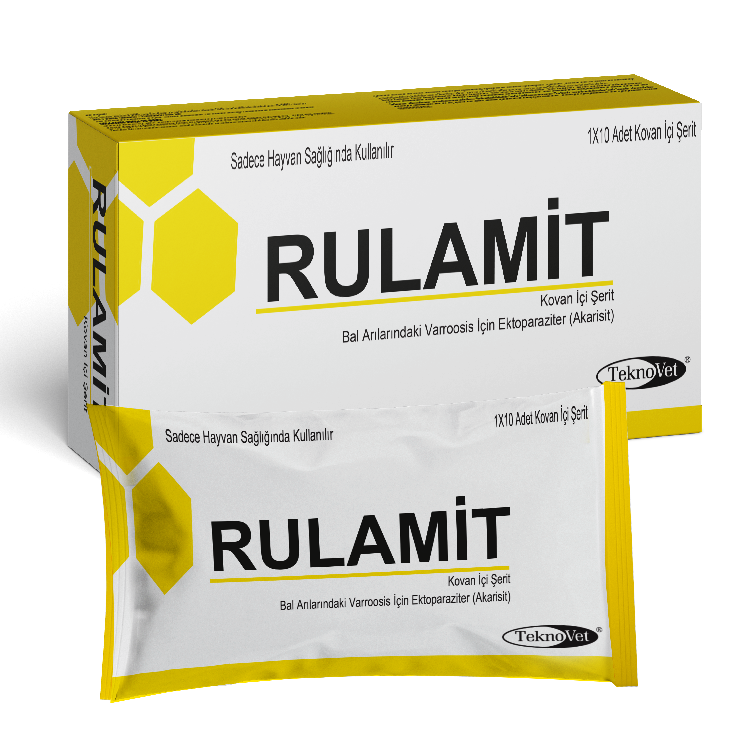COMPOSITION
Each 3 x 20 cm plastic transparent hive strip contains 500 mg Amitraz and 150 mg butylhydroxytoluene (E 321) as an antioxidant.
INDICATIONS FOR USE
It is used in the treatment of varroosis caused by
Varroa destructor which is sensitive to amitraz in honey bees.
ADMINISTRATION ROUTES AND AMOUNTS
Rulamit Bee-Hive Strip is designed for use inside the hive.
Use 2 strips per hive (i.e. 500 mg x 2 = 1000 mg Amitraz, per hive with 10 frames of bees).
Hang the strips between the two frames, in the middle so that the bees can come into contact with them.
Place the strips between the frames where the bees have the most mobility. Hang the strips so that bees have free access to both sides.
Hive types:
- Langstroth type hive (hive surface area 160 dm2): In this hive; It is recommended that place the product through each appropriate strip between frames 3rd and 4th, and the other between frames 6th and 7th.)
- Dadant type hive (surface area 220 dm2): In this hive; It is recommended that place the product through each appropriate strip between frames 3rd and 4th, and the other between frames 7th and 8th.)
- Layens type hive (surface area 240 dm2): In this hive, It is recommended that place the product through each suitable strip between the 5th and 6th frames and the other between the 9th and 10th frames.)
The strips should be removed after 6 weeks if there are no puppies. Besides, the strips should be removed after10 weeks if there are puppies
Usage precautions and application timeline:
The product should be used when hatchability is low compared to peak levels.
If there is no hatching (refers to the eggs, larvae and pupae of honey bees) or is at its lowest level, the strips can be removed after 6 weeks of treatment. If there is hatching, leave the strips in place for 10 weeks and remove the strips at the end of treatment. If the strips are covered with propolis and/or beeswax, in the middle of the treatment it is possible to gently scratch the strips using a beekeeper's hive scraper tool to remove the wax and propolis.
Then, the strips should be placed back into the hive and repositioned if necessary according to the application instructions (it is applicable in case of changes to the bees’ hive or hatching area).
The recommended time for treatment is when there are no honeycombs. (honey layers) It is a time after the last honey harvest (late summer/autumn) and before the start of honey-producing activity in the spring. It is recommended to check for varroa infestation to determine the optimal time for treatment.
Additionally, the product must be applied before the bees form winter colonies. This time may vary from region to region because climates will differ from region to region. Therefore, incubation and climatic conditions should be considered before product application.
WITHDRAWAL PERIOD(S)
For honey, it is 0 (zero) days. Do not use the product during honey (nectar) flow. Honey obtained during the treatment should not be offered for human consumption. It should not be applied 6 weeks before at the beginning honey set and during the honey set. Do not use honey in hatching area. Do not harvest honey while the treatment is applied. Hatching honeycomb should be replaced with new foundation honeycombs at least every three years. Do not use incubation frames as honey frames.
MARKETING PACKAGING
Sold as cardboxes containing 1 or 5 aluminum foil bags. Each aluminum foil bag contains 10 bee-hive strips, each measuring 3 x 20 cm.
